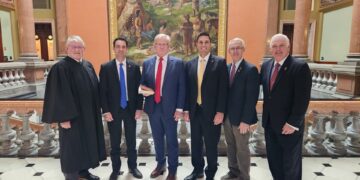By Nancy Thorner and Bonnie O'Neil -
There is a growing concern among citizens that some government officials have been and are continuing to abuse their authority. There are many examples and evidence of this starting at the very top level of our government. Will there be further conflicts, and if so will it be the catalyst for further insurgency by citizens against government?
Linking the Ferguson example in 2004 with that of rancher Clive Bundy's Nevada dust-up within the same year (See Article 1 published at Illinois Review, Friday, February 12), and most recently the new conflict among more ranchers and government at the Malheur National Wildlife Refuge that resulted in police killing one of the ranchers, seems to point toward a developing pattern. One day after Thorner and O’Neil’s article was published at Illinois Review, news media information revealed the heavy hand of law once again struck at both the City of Ferguson and rancher Clive Bundy.
Ferguson was under pressure by the federal government (Attorney General Loretta Lynch) to submit to specific demands. Ferguson officials did not think it in their community's best interest to comply with the new procedures demanded of them, and Attorney General Lynch's federal boots stomped down. Ferguson has now become a political tool for a federal power grab. The city may well end up with a federalized police department.
In an unexpected twist, federal authorities not only arrested the ranchers who had occupied the Malheur National Wildlife Refuge, but they also arrested Cliven Bundy. At 69, Bundy was charged with "conspiracy, assault on a federal officer, obstruction, having a weapon, and other offenses stemming from his role as the leader of an April 2014 clash with federal officials at his ranch near Bunkerville, Nevada. The 32-page criminal complaint cites Mr. Bundy’s role “in recruiting about 200 armed supporters to face off with federal agents who had come to remove his cattle from the Bureau of Land Management property in 2014 over a grazing dispute.
The Malheur National Wildlife Refuge
As alluded to in the above paragraph, in early January of this year another explosive situation developed between ranchers and the government. This incident involved father and son ranchers, Dwight and Steven Hammond and resulted in the occupancy of the Malheur NationaI Wildlife Refuge. It all began over a “controlled burn" on Hammond's land, initiated as a “clearing” of dry grass land to protect their family's property from a potential wildfire. The federal government initiated charges claiming the Hammonds had burned federal land in the process. The Hammonds acknowledged the fire accidentally strayed and burned grass on federal land. The Hammonds were arrested and a trial resulted. The judge sentenced Dwight Hammond to three months in prison and his father Steven Hammond to one year in prison, even though there was no proof of deliberate arson.
Both men completed their sentences, but after their release from prison, a federal judge stepped onto the scene claiming the punishment of the Hammonds was not enough. The Ninth Court of Appeals stated: “Given the seriousness of arson, the ranchers should have been given a five-year sentence; the reduced sentence was grossly disproportionate to the offense.” Dwight Hammond called the new ruling a “death sentence," largely due to his advanced age. The Hammonds appealed to the Supreme Court, but it would not accept the case. Currently, Dwight and Steven Hammond are appealing to President Obama for clemency.
Ranchers support Dwight and Steven Hammond
The new sentence was deemed exceedingly unfair by fellow ranchers, who believed the Hammonds' rights had already been violated by the first sentence. Ranchers knew an arson charge was inappropriate for what was actually a common occurrence by ranchers in the area. There is always a risk with controlled burns exceeding the intended limit, but there is a bigger risk to the land and property without the “burn.” Ranchers had reached a limit to what they would endure from officials who appeared to them as enemies just looking for ways to discourage, discredit, and harm them.
A group of ranchers joined together in a peaceful protest near the Hammonds' home. Brothers, Ryan and Ammon Bundy, driven by their growing anger of perceived injustices, broke away from what had been a peaceful protest and led a group of armed militiamen to take over the unoccupied headquarters of the Malheur National Wildlife Refuge on January 2, 2016. It soon became obvious that the Refuge was being occupied by the renegade ranchers.
The following explanation was given by the ranchers occupying the Refuge:
“The facility has been the tool to do all the tyranny that has been placed upon the Hammonds. We’re planning on staying here for years. This is not a decision we’ve made at the last minute.”
Ryan Bundy further stated, “Many of the men at the refuge are willing to fight and die to protect the rights of states, counties, and individuals to manage local lands." Sadly, that proved to be true in the days ahead.
FBI Challenges the Killing of a Rancher
The Malheur NationaI Wildlife Refuge occupation went viral in the media on January 26, 2016, when the mostly peaceful occupation turned violent. Law enforcement officers shot and killed rancher Robert "LaVoy” Finicum as he drove on Highway 395, about fifty miles north of the occupied Malheur site.
Not helpful was the conflict that developed in Harney County, Oregon over the nature of Finicum's death. In an interview the day before he died, Finicum claimed that the government appeared to be ramping up for action. He voiced his concern saying: “They’re doing all the things that show that they want to take some … action against us.”
Kris Anne Hall, legal advisor for the Coalition of Western States and a defender of the armed Oregon take over, stated during an interview on The Joe Miller Show that no shots were fired by any of the protesters, but multiple shots were fired by federal agents at the protesters' car. Additionally, Ms. Hall claims LaVoy Finicum was "summarily executed" while on his knees with his hands in the air. This claim was disputed by police, but there is no doubt Finicum was shot at least six times, while no shot originated from Finicum. Further contradicting Ms. Hall are police claims that Finicum was going for his gun when shot. But there are witnesses who claim Finicum was shot multiple times, including in the face at close range after he was likely dead.
As of February 9, 2016, the autopsy report has not been released, which could prove helpful in determining whose version is most accurate. However, the FBI did release a video of the chase and the shooting on January 28, 2016, to the “Oregonian“ that carefully examined all in slow motion. The detailed second by second account of the shooting can be viewed on this site.
In existence is another video of the police chasing Finicum's car, taken from a helicopter overhead. After the Finicum family viewed it, they called the shooting unjustified, even going so far as to accuse the authorities of a cover-up. The new claims are bolstered by the account of Shawna Cox, who was riding in Finicum's vehicle during the chase and shooting. Another passenger, Victoria Sharp, provided confirmation that Finicum was fired upon before he left his truck.
Conservation Plan negotiated as Beacon of Hope
What makes the Malheur National Wildlife Refuge flare-up so upsetting to stakeholders — including ranchers, environmentalists, and federal agents — was a conservation plan that had been agreed upon for the Malheur National Wildlife Refuge in the Harney Basin. The plan took three years to negotiate. An agreement was reached that considered ranchers' livelihoods, ecological concerns, and local economic sustainability. Accordingly, the plan had become a beacon of hope in the region, as well as in other rural communities faced with similar conflicts.
Joel Webster, Western Lands Director of TRCP (Theodore Roosevelt Conservation Partnership), is credited with engineering the conservation agreement. In an interview Webster said:
“We try to sit down with people and develop a shared vision early on in the process or at least make sure our vision isn’t stepping on theirs. You do it in a way that minimizes conflict. Collaborative planning processes such as the one worked out in the Harney Basin are the essence of good land management."
Nevertheless, conflicts do arise because the economic survival of some ranchers depend on access to water on public lands located in the high desert owned by the U.S. Bureau of Land Management (BLM), especially during the critical spring and summer months. Some ranchers even purchase grazing and water access to BLM owned high desert public land. Furthermore, some landowners are not as amenable to that kind of collaboration with the federal government, claiming officials seek what is called state sovereignty over public lands: a transfer of rule making an administrative authority over taxpayer property: from federal agencies to state and county authorities.
It might come as a shock to many that the federal government owns 650 million acres of land or 1/4 of all the land in the U.S. Most of the land is in the West.
Movement growing to seize land from Centralized Agencies
Webster is concerned over a growing movement to seize land management decisions away from centralized agencies. His concern is based on how more and more ranchers and farmers — called "radicals" by Webster — are speaking up against public lands and oppose government control of any kind. The result is a perception of injustice. As in the Hammond case, there is a shrinking gap between those like Bundy and moderates who want to work with the government. Concern also exists that the desire to wrest management authority away from public representatives at BLM and FWS could possibly become mainstream.
Webster understands why ranchers are upset, but he does not see Bundy's’ approach as a solution. As Webster noted:
“It clearly seems unreasonable to put somebody in prison for five years for burning 139 acres of public land. There are some legitimate frustrations out there like that.” Webster then added: “But we have a system of laws put in place for reasons. You get engaged if you don’t like the laws and try to change them. You don’t hold a stand-off.” Ranchers claim they tried the legal approach without success.
Impact of Standoff Unknown
It is difficult to ascertain the kind of impact the refuge standoff will have on the freshly-healed partnerships negotiated by Webster between ranchers and federal workers in the community prior to the Malheur National Wildlife Refuge occupation.
If the November 2014 Senate campaign is an indication, in which Cory Gardner (R) defeated Mark Udall (D) for U.S. Senate, the public seems to have sided with the ranchers, The Gardner/Udall political contest was largely about the smothering effects of government regulation. There does appears to be a growing sympathy for the ranchers as they are perceived as hard-working, honest people who are land rich and dollar poor, challenged by continual harassment inflicted by government agencies. The recent shooting of Finicum can only add to the community's concern.
The standoff at the Malheur National Wildlife Refuge finally came to an end, when on Wednesday, February 10, 2016, forty-one days after the occupation of Malheur began, the last rancher surrendered to the FBI.
There are inevitable consequences when crisis situations are not successfully managed before tempers flare and situations become harder to control. Most everyone ends up losing in the end.
Granted, the conflict that created the situation in Oregon is far from over. The ranchers involved have accomplished their primary goal of having their concerns made public, although not to the extent of those who rioted, thrashed, and burned Ferguson or those who marched on the streets of large cities chanting “No justice! No peace! No racist police!”
Unfortunately in calling attention to their plight, one rancher paid the ultimate price, his life, for doing so. Will the authorities now be more open to initiating productive discussions to hear ranchers’ concerns? The fate of the protestors arrested and taken into custody might be an indicator of what the future might hold for the Great Basin region of this nation.
As for Ferguson, many now believe much of what transpired in Ferguson was a deliberate, orchestrated effort to federalize the police, to eliminate local independence through strong armed “consent," and to send a message to other police departments around the country that the same thing can and will happen to them if they do not submit to federalization. It appears to be a first step to initiate the Obama “civilian national security force” that he called for in July, 2008.
It seems prudent for all citizens to be alert to what is happening and realize this is not just about a few rare incidents; it is about protecting our Country, Constitution, and honest citizens from intrusive government actions.







